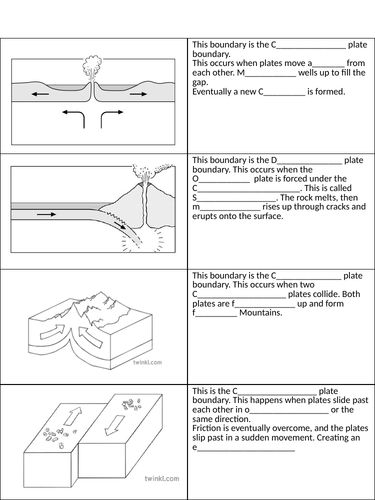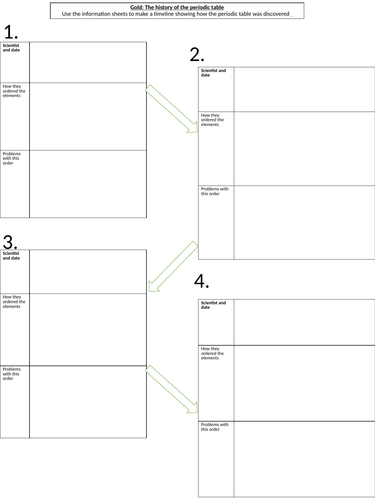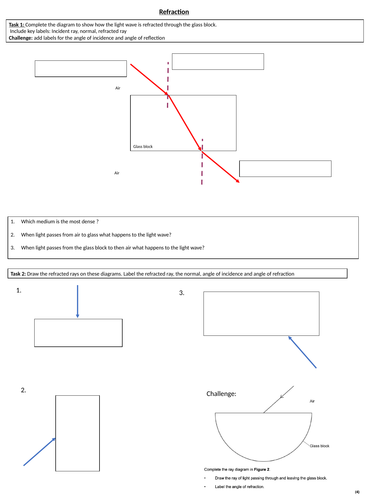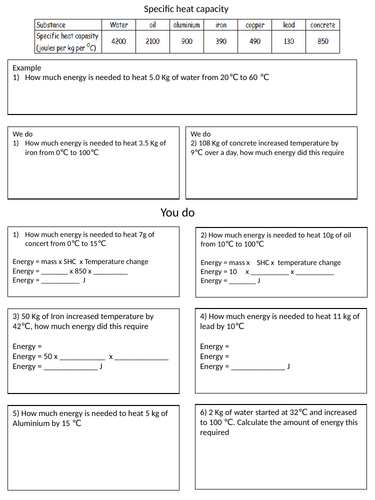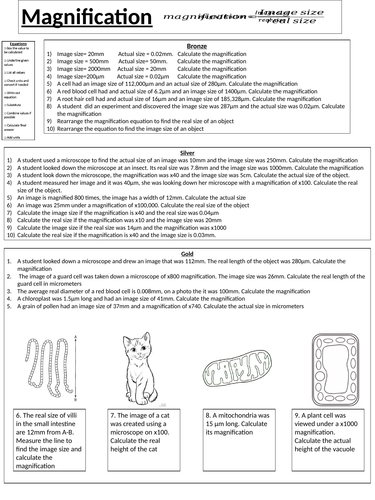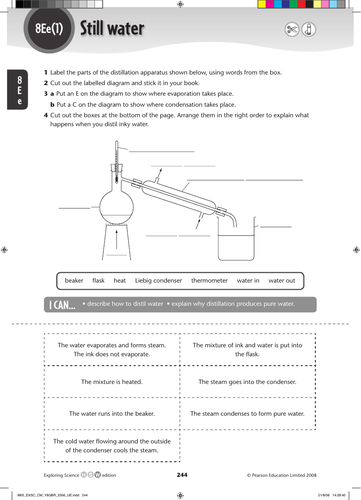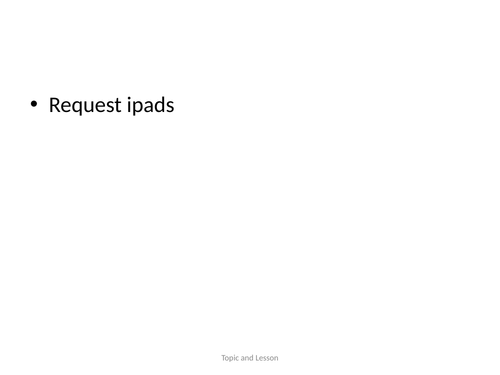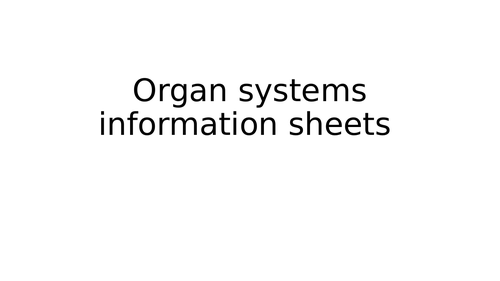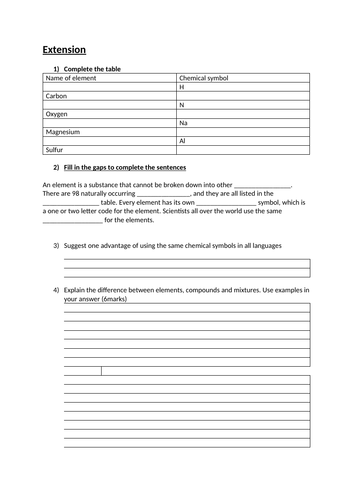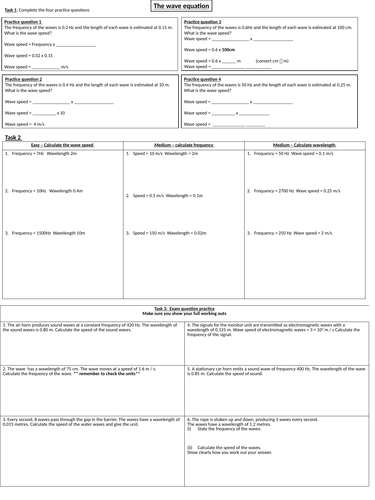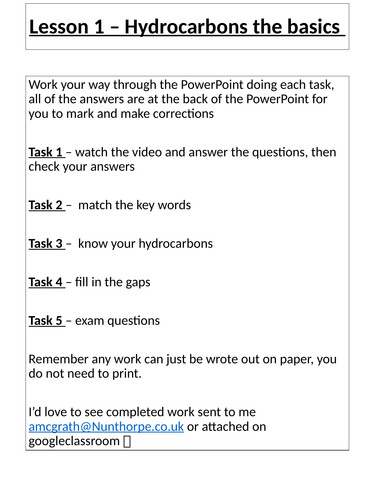
124Uploads
30k+Views
8k+Downloads
All resources

Plate boundaries - differentiated tasks
Low ability - fill in the gaps activity with the first letter of each missing word
Middle ability - fill in the gaps
High ability - explain themselves

History of the periodic table KS3
Differentiated retrieval starter questions.
Go through answers
Main –
Add periodic table to key words, watch video about history of periodic table
Using differentiated sheets, create timeline of history of the periodic table
Label modern periodic table and answer questions
Plenary
Carton elements – identify the carton character

Magnification equation worksheet
Differentiated practice using the magnfication equation.
Bronze: very simple, simple put the numbers into the equation
silver: need for rearranging equation
gold: need for rearranging equation and converting between units, and measuring image size from image

Simple Distillation KS3
Aimed at mixed ability year 8 class
Starter: would you drink dirty water, how do you think you could clean it?
Main: SMSC link to how many people dont have clean water, fill in SMSC grid based on video
Explain simple distillaation and equiptment, label diagram of equiptment
Watch distillation demo
Bronze/ Gold task to explain distillation
Extension task available on powerpoint
Plenary: Exam question

Fractional distillation KS3
Aimed at a mixed ability year 8 class
Starter: work out the link between the pictures
Main: Explain what crude oil is and what fractional distillation is
Watch video, answer questions, green pen mark questions
Complete level 1/2/3 worksheets explaining fractional distillation
Extension: research task linking SMSC and crude oil
Plenary: What problems would we encounter if we banned all crude oil now

Magnification
Starter: Retrieval starter, based on prior knowledge about animal and plant cells
Main:
explaination of how to convert between common units used in biology
Differentiated task to convert between units
-explaination of how to use standard form
questions to practice on standard form
microscope questions to explain examples
differentiated magnfication worksheet
Plenary:
plenary grid with questions from this lesson and based on animal and plant cells. to be done individually or as a group

Elements and compounds KS3
Elements, compounds and mixtures- Some resources are from other areas on TES
Targeted at year 8 mixed ability class.
Starter: 5 minutes timed activity, challenege to see how many words students can make from the periodic table
Main: Go over definitons of elements/compounds/mixtures.
Then use these definitons to identify which particle pictures are elements/compounds
Go over rules of particle diagrams, then a choice of higher or lower ability sheet.
Higher ability sheet: students need to draw particle diagrams
lower ability sheet: students need to identify the correct particle picture
Extension: Worksheet, including tasks such as identifying elements, a fill in the gaps activity, 6 mark practicce question to explain the difference between elements/compounds/mictures
Plenary: Break the code using the periodic tab;e

C1.1 atoms
Aimed at a mixed ability year 9 class. Some worksheet from other areas on TES
Starter
Stick in objective sheets for this topic, also stick in common formulae sheets
6 true or false questions – green pen mark
Main –
Think, pair, share – what is an atom? Share ideas, write a sentence to explain what an atoms is. Extension task to label an atoms (level 6 objective) but there is a lesson on the structure of the atom later in this topic
Copy definitions for element/compound/mixture onto worksheet. Then cut up pictures and decide if they are a compound element of mixture
Extension: find the element to spell the cartoon characters worksheet
Identify atoms/elements and name formula worksheet - green pen mark
Extension: write the name of the formulae
Plenary
Whiteboards out, write down the symbol for the elements I shout

C3.3 Ionic bonding - foundation
Aimed at a lower ability class
Starter Activity
Ions recap, what charge do elements have in different groups
Stretch question to think about how group 1 and 2 will interact with group 6 and 7
Main –
Go through the video and answer the questions, go through answers
Practice drawing ionic compounds Extension: explain the difference between KBr and K2O
Go through the answers which are on the slides
Exam question practice to move onto if have a chance
Plenary
4 mark exam question – peer assess
Good to show the detail they need in their answers

C11.3 greenhouse gases
Aimed at foundation students, targets of level 4
Starter: differentiated bronze/silver/gold starter questions with answers
Main:
Draw the greenhouse effect using info from powerpoint. extension question to challenge students
Fact hunt: questions to answer using textbook
Video on deforestation, questions to answer from video
Plenary: animated true/false statements

C11.5 atmospheric pollutants
aimed at foundation level 4 targets
Differentiated bronze/silver/gold starter
Main: recap complete and incomplete combustion, put piece of pot over blue/yellow flame on bunsen burner
Students fill in worksheet, to say what they saw and the difference between incomplete and complete combustion
Students fill in information grid using textbooks, to find the causes of the atmospheric pollutants and the problems with them
Answers for students to check their answers with
Bundle

C11 - The earths atmosphere
All resources aimed at foundation students
C11.1 + C11.2 combined into one lesson
C11.3 greenhouse gases
C11.4 global climate change
C11.5 atmospheric pollutants

Potable water differentiated worksheet
Bronze/silver/gold differentiated worksheets
To show how potable water is made
Aimed at low ability students

C12. treating waste water
For low ability students. targets level 4
Starter: differentiated stater based on prior learning of the topic
answers on following slide
Main: think pair share: where do we get waste water from
video: watch a video, try and pick out what the stages of treatment for waste water are
differentiated worksheets, to explain the process of waste water treatment
Extension: differentiated extension questions
Plenary: copy and complete two sentences

Eukaryotic and Prokaryotic cells
Combining both B1.2 and B1.3 from the kerboodle topic
Starter: No goal starter, images of plant and animal cell and a microscope. students can add any information they already know. Images can be printed or a list of what they know can be wrote. To be referred to at the end of the topic, assess prior knowledge
Main:
Label plant and animal cell, differentiated version available, animated answers embedded in the powerpoint
Match structure and function of organelles
Show students bacterial cell, students draw and label their own, before filling in the comparison tick box to compare animal, plant and bacteria cells. Stretch task available
Explain key words prokaryotic and eukaryotic, then students complete the assessed questions showing understanding of differences between these cells. Self assess answer using mark scheme
Plenary
Plenary grid, can be done individually or as teams. Covers key concepts from the lesson, answers on the following slide

wave equation
Aimed at foundation students
Starter: Retrieval practice questions based on P1
Main: Mini recap of parts of a wave and key definitions.
Both period and wave speed equation demonstrated on powerpoint with examples and practice.
Then move onto the SLOP worksheet with faded practice and exam questions. All answers on the power point
Plenary: Mini white board plenary

